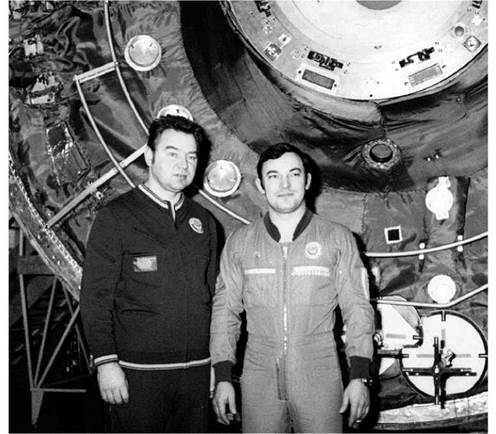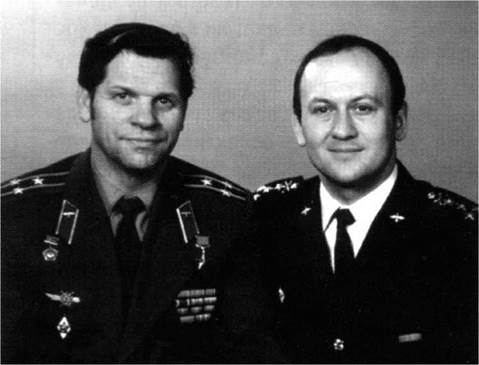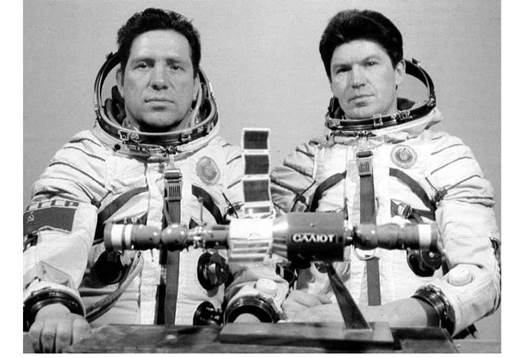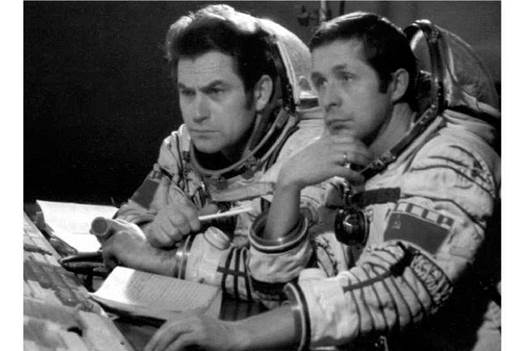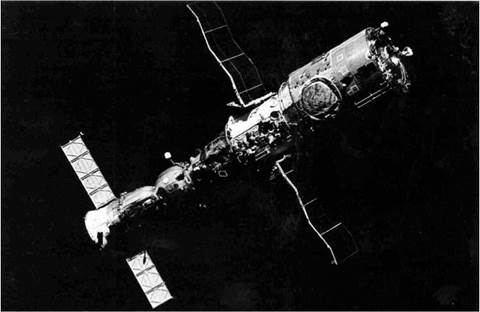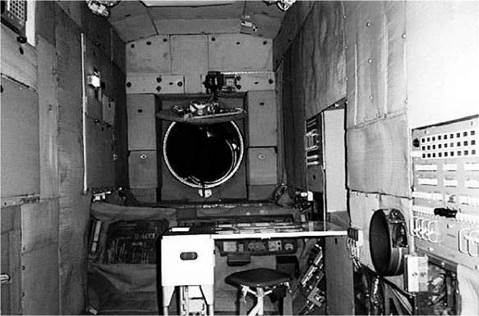Salyut 6: Space station operations defined
Salyut 6 represented the major step forward in space station operations that the Soviets had been planning for some time. Launched on 29 September 1977, it featured a second docking port, as well as an Extravehicular Activity (EVA) hatch. The second docking port was a significant addition because it allowed the station to be resupplied by Progress cargo spacecraft, an essential capability for long-term habitation. It would also allow for the possibility of visiting crews who would dock with the station, stay for about a week, and then return in the older Soyuz leaving the new one for the long-duration crew.
The concept behind the Progress spacecraft was a simple one, and solved the problem that all previous space stations, including Skylab, had encountered. How do you keep a long-duration crew in orbit, when they are eventually going to run out of supplies of food, clothes, and of course, oxygen? The Soyuz spacecraft could only carry so much cargo in addition to its crew, but if the crew, and all of their life support systems were removed, this released a lot more room for cargo. The result was to become the Progress, essentially a leaned down Soyuz meant only for cargo and fuel, and designed only to make a one-way trip. The heat shield was also removed; it was unnecessary because the idea was that once the resident space station crew had unloaded all of the fresh cargo, they would load the craft with all of their unnecessary equipment, and rubbish, and it would then undock and be remotely commanded to re-enter and burn up. This also made the separate descent module unnecessary, and it was instead used as a fuel tank to allow the Progress to replenish the propellant tanks of the space station. In truth, it would become apparent in later years that the Progress did not solve all of a space station supply problems. It could not return anything to Earth obviously, which meant that crews returning to Earth would continue to need to bring back experiment results with them in the Soyuz, which had a limited return weight. It also turned out that not all of a stations unwanted material could be disposed of in a Progress, and that long-lived space stations would accumulate more and more clutter.
The new ability for crews to make short visits to an accupied station opened up the prospect for the first time of visits by cosmonauts from other countries. In a response to the NASA selection, in 1976, of non-pilot mission specialist astronauts for upcoming space shuttle missions, the Soviets launched the Inter-Kosmos program, with the participation of fraternal communist states, initially Bulgaria, Cuba, Czechoslovakia, East Germany, Hungary, Mongolia, Poland, and Romania in joint space flights with the Soviet Union. In 1979 three non-communist nations were added to this list, France, Vietnam, and India, and all of these flights would be carried out between 1978 and 1983. This agreement led in 1985 to an expansion of the program to all countries, communist or not, organized by GlavKosmos. This led to countries such as Afghanistan, Austria, Japan, and the United Kingdom agreeing to manned space flights with the Soviet Union. All of this, however, lay in the future, for now the first guest cosmonauts were training to fly on board Salyut 6.
Operations did not start well with the launch of Soyuz 25, which unfortunately could not dock with Salyut 6, probably due to a fault in the Soyuz docking system, and had to return to Earth. This resulted in an upheaval in the schedule, as this first crew had been due to occupy the station for about two months, during which time they would receive the first on-orbit visitors, and also oversee the docking of the first Progress cargo vehicle. This failure forced mission planners to attempt a winter launch, which, for safety reasons, they were not generally keen on. However, Soyuz 26 was launched on 10 December 1977 and docked, this time with the rear port, successfully a day later. This mission would set the pattern for all future space station operations to follow. The crew of Yuri Romanenko and Georgi Grechko remained on the station for a record breaking 96 days. In view of the failure of Soyuz 25 to dock, they carried out an EVA to check the front docking port, during which they found nothing out of the ordinary. They received their first visitors when the crew of Soyuz 27, Vladimir Dzhanibekov and Oleg Makarov, docked to the front port and formed the first four-man crew in history. Dzhanibekov and Makarov departed on 16 January 1978 after a six-day visit, taking the older Soyuz 26 home and leaving the rear docking port available for the first Progress cargo spacecraft. The final component of modern space station operations was completed with the launch, on 20 January, of the first Progress cargo spacecraft. This docked at the rear port of Salyut 6 two days later. It was relieved of its cargo and loaded with unneeded equipment, rubbish etc., and then pumped fuel into the Salyut’s propulsion tanks. It undocked from the station on 6 February, tested its back-up rendezvous system, and re-entered the Earth’s atmosphere two days later. Again, this would become a standard procedure for future space station operations, continuing today with the ISS. This procedure will not change until the ESA’s ATV cargo craft starts operations in 2007.
The second crew of visiting cosmonauts on board Soyuz 28 docked with the rear port on 3 March. Alexei Gubarev was accompanied by the first international Inter – Kosmos cosmonaut, Vladimir Remek from Czechoslovakia. The visitors undocked from the rear port after a flight of nearly eight days, this time in the same Soyuz they had launched in, and landed safely. Soyuz 27 undocked from the front port on 16 March with Romanenko and Grechko aboard. Their flight, which had surpassed the record set by the final U. S. Skylab crew of 84 days, had been a tremendous success;
|
Soyuz 26 crew |
they had proved every aspect of space station operations and set the path for all future long-duration expeditions.
The second main expedition to Salyut 6 was undertaken by the Soyuz 29 crew of Vladimir Kovalyonok and Alexandr Ivanchenkov. They launched on 15 June 1978, and docked with the front port the next day. They were to receive two Inter-Kosmos crews, one with a cosmonaut from Poland and the other from East Germany, unload and repack three Progress cargo craft, make an EVA to retrieve material samples from the hull of Salyut 6, and swap the newer Soyuz 31 from the rear port to the front port in order to clear the rear for future Progress dockings. They returned to Earth on 2 November after further extending the duration record to 140 days.
Unfortunately, things would not go quite as smoothly for the third expedition. Vladimir Lyakhov and Valery Ryumin on board Soyuz 32 launched successfully on 25 February 1979, and docked with the front port the next day as per normal. They were expecting to stay for about six and a half months, and apart from working to try
|
Soyuz 28 crew, first Inter-Kosmos flight |
and fix a small leak in one of Salyut’s propellant tanks the mission was preceding as planned. Their first visitors were not so lucky. Soyuz 33 as usual contained an international crew with the guest cosmonaut from Bulgaria, but when they got within range of the station the main engine on their Soyuz misfired, and the docking was aborted. The bitterly disappointed crew made a manual re-entry the next day. This had implications for the long-duration crew. What would happen if their ferry was similarly afflicted? Even if it were not, it would need to be replaced before they could come home; the crew of Soyuz 34 had been due to bring them a new ferry and go home in the older one, but this was now in doubt. In the end it was decided to launch Soyuz 34 unmanned, and use the docked Soyuz 32 to return some samples and experiment results to Earth, also unmanned. The crew then swapped Soyuz 34 to the front port to again allow Progress dockings. The dramas for the resident crew were not yet over. The 10 m diameter KRT-10 radio telescope antenna, which had been deployed from the rear port, became entangled with a fixture on the hull when the crew attempted to jettison it. Therefore, on 15 August, the crew ventured outside to cut the antenna free, doing so with little difficulty. While outside, they and also retrieved sample cassettes from the hull of the station. On 19 August 1979, the crew climbed aboard Soyuz 34 and came home having spent 175 days on board Salyut 6.
|
Soyuz 32 crew |
Remarkably, the crew for the fourth expedition consisted of Leonid Popov and, making two flights in a row, Valery Ryumin. Ryumin was a last minute replacement for Valentin Lebedev, who had injured a knee shortly before launch. So it was that Ryumin found himself back on board Salyut 6 on 10 April 1980 reading the note that he had left for the next long-duration crew! In contrast to the previous mission, this crew entertained four visiting crews, three Inter-Kosmos and one carrying out the first manned test of the new Soyuz-T spacecraft. On 11 October the main expedition landed safely back on Earth after a mission lasting a record breaking 185 days. This meant that Ryumin had spent 360 days in space, making him the most traveled cosmonaut or astronaut at that time. He would fly again, but not until 1998, and on board a U. S. space shuttle to visit a Russian space station, a joint mission that would never have been predicted in the cold war days of 1980.
The final expedition to Salyut 6 began on 12 March 1981 when Soyuz-T 4 was launched with the crew of Vladimir Kovalyonok and Viktor Savinikh. This was after Soyuz-T 3 had flown a short three-man mission to the vacant station, both to replace some of the systems of Salyut 6, and to verify the three-man capability of the new Soyuz-T. The main expedition was to last for 74 days and receive two visiting Interkosmos crews, both using the older Soyuz spacecraft. The main expedition undocked and landed on 26 May 1981, closing the chapter on the fantastically
|
Soyuz-T 4 crew |
successful Salyut 6 station. Later that same year, Cosmos 1267, which had been in orbit since April, docked with the forward port. This helped to prove to engineers the concept of expanding future stations with separately launched modules. Cosmos 1267 was, in fact, a remnant of the Almaz program, as it was one of Vladimir Chelomei’s TKS designs that had been launched on an autonomous mission lasting 57 days before it docked with Salyut 6.
Salyut 6 had been occupied by five long-duration crews for a total of 684 days; it had also been visited 11 times by short-duration crews, 9 of which carried international crewmembers. Salyut 6 was finally de-orbited on 29 July 1982 after four years and ten months in Earth orbit.
|
Salyut 6 in orbit |
|
Inside Salyut 6 |











